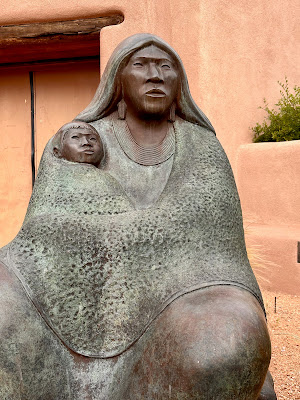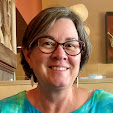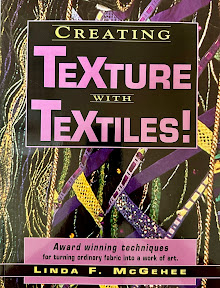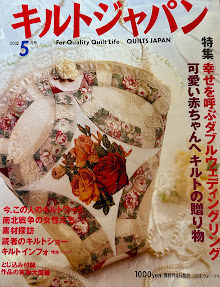There are so many museums in Santa Fe that I couldn't go through them all in two days, but I did make it to the Museum of International Folk Art and the Museum of Indian Arts and Culture. They're both on Museum Hill, where I also enjoyed the sculpture garden.
The folk art museum had a special exhibit on the art of Alaska Native parkas, and they truly are works of art. Mainly made by women, the parkas are expressions of deep respect for the animals of land and sea from which the parkas are made. They represent the circular relationship between animals, hunters, and parka makers.
According to Native knowledge, the animal chooses a hunter worthy of its life. The parka maker then imbues the piece with good thoughts that will live with the piece forever. With each piece sewn together, the artist ushers the animal's spirit into the next stage of being. Both hunter and parka maker complete these tasks out of deep respect for the life given. The hunter who wears the parka then attracts another animal, and the cycle continues.
This parka is made from the skin of 30 chum salmon that were eaten before the skin was processed into water-resistant "leather." The maker used whole fish cut to dry in one piece, then she washed it with cold water and soap to make it strong and stiff. The patches cover holes where the dorsal fin would have been.
The museum had folk art from all over the world, including this tapestry. I don't know where it's from because you needed to refer to an exhibition notebook for information and I thought that would be too much work. Now I wish I had done it. Instead, I just wandered through and enjoyed looking.
There was an exhibit in all of my favorite clear bright colors (above) on the Mexican art of paper and paste that included huge sculptures from skeletons to toys to masks, called cartoneria, that are used in festivals.
An unexpected exhibit was about Japanese yokai -- ghosts, demons, monsters and other kinds of supernatural beings and mysterious phenomena that, according to folklore, interact with humans to scare us. Sort of like our ghost stories told around the campfire. Part of the exhibit was similar to a Halloween haunted house, where you entered a darkened passageway and big colorful creatures screamed, lights pulsed, and my heart raced a bit.
The Museum of Indian Arts and Culture had a special exhibit called Painted Reflections that emphasized the sophisticated visual qualities of Pueblo pottery through the designs painted on the pots.
We spent quite awhile watching a fascinating video of Maria Martinez of the San Ildefonso Pueblo creating her famous polished black pots. For more on her: https://en.wikipedia.org/wiki/Maria_Martinez

Canteen, 900-1150
There were pots from the year 900 up to contemporary times, all stunning.
Storage olla, ca. 1900 (Hopi)
"Father Sky, Mother Earth," 1995
Tony Abeyta, Navajo
The painting above and hand below are two of my favorites from the rest of the museum.
Turquoise Hand Ring, ca. 1970s-1980s
Leo Coriz (Kewa/Santo Domingo Pueblo)
A grandchild of the artist said, "Grandpa Leo always had his own designs. He would say, 'Don't let anyone tell you what to design, let the Creator decide what to do, and let that flow through you.' Grandpa Leo originated the hand design for our family."

Throughout the museum, the concept of cycles was apparent, from the architecture to the art. I could've spent many hours and many days there.

This mother and child is from the sculpture garden on Museum Hill.
And here is our group of travelers with "Apache Mountain Spirit Danger" in the central area of Museum Hill.
Here we are with the fanciful "Water Rabbit."

The Museum of Contemporary Native Arts is downtown, but it was closed when we walked by. I really wanted to go inside, because look at the colors out front!
Near that museum, we visited the Loretto Chapel to see its spiral staircase. The Sisters of Loretto credited the carpenter St. Joseph with its construction in the 1800s. It's been the subject of legend, and its construction and builder were considered miraculous by the sisters.
Coming next and last -- Taos Pueblo!
Have a colorful day































No comments:
Post a Comment